In development, we often encounter some requirements about delayed tasks. for example
-
If the order has not been paid for 30 minutes, it will be automatically cancelled
-
60 seconds after the order is generated, send a text message to the user
For the above tasks, we give a professional name to describe, that is, delayed tasks. Then a question arises here. What is the difference between delayed tasks and scheduled tasks? There are the following differences
Timed tasks have a clear trigger time, while delayed tasks do not
A scheduled task has an execution cycle, while a delayed task executes within a period of time after an event is triggered, and there is no execution cycle
Scheduled tasks generally execute batch operations, which are multiple tasks, while delayed tasks are generally single tasks
Next, let's take judging whether the order times out as an example to analyze the scheme
Scheme analysis
(1) Database polling
thinking
This scheme is usually used in small projects, that is, it scans the database regularly through a thread, judges whether there are overtime orders through the order time, and then performs operations such as update or delete
realization
Bloggers used quartz in the early years of that year (about the internship). Let's briefly introduce it
The maven project introduces a dependency as follows
<dependency> <groupId>org.quartz-scheduler</groupId> <artifactId>quartz</artifactId> <version>2.2.2</version> </dependency>
Call Demo class MyJob as follows
package com.rjzheng.delay1;
import org.quartz.JobBuilder;
import org.quartz.JobDetail;
import org.quartz.Scheduler;
import org.quartz.SchedulerException;
import org.quartz.SchedulerFactory;
import org.quartz.SimpleScheduleBuilder;
import org.quartz.Trigger;
import org.quartz.TriggerBuilder;
import org.quartz.impl.StdSchedulerFactory;
import org.quartz.Job;
import org.quartz.JobExecutionContext;
import org.quartz.JobExecutionException;
public class MyJob implements Job {
public void execute(JobExecutionContext context)
throws JobExecutionException {
System.out.println("I'm going to scan the database...");
}
public static void main(String[] args) throws Exception {
//Create task
JobDetail jobDetail = JobBuilder.newJob(MyJob.class)
.withIdentity("job1", "group1").build();
//Create trigger} every 3 seconds
Trigger trigger = TriggerBuilder
.newTrigger()
.withIdentity("trigger1", "group3")
.withSchedule(
SimpleScheduleBuilder.simpleSchedule()
.withIntervalInSeconds(3).repeatForever())
.build();
Scheduler scheduler = new StdSchedulerFactory().getScheduler();
//Put the task and its trigger into the scheduler
scheduler.scheduleJob(jobDetail, trigger);
//The scheduler starts scheduling tasks
scheduler.start();
}
}
Run the code, you can find that every 3 seconds, the output is as follows
I'm going to scan the database...
Advantages and disadvantages
Advantages: it is easy to operate and supports cluster operation
Disadvantages: (1) large consumption of server memory
(2) There is a delay. For example, if you scan every 3 minutes, the worst delay is 3 minutes
(3) Suppose you have tens of millions of orders and scan them every few minutes, which will cause great loss of the database
(2) Delay queue of JDK
thinking
This scheme is implemented by using the DelayQueue of JDK, which is an unbounded blocking queue. The queue can get elements from it only when the delay expires. The objects put into the DelayQueue must implement the Delayed interface.
The workflow of DelayedQueue implementation is shown in the figure below
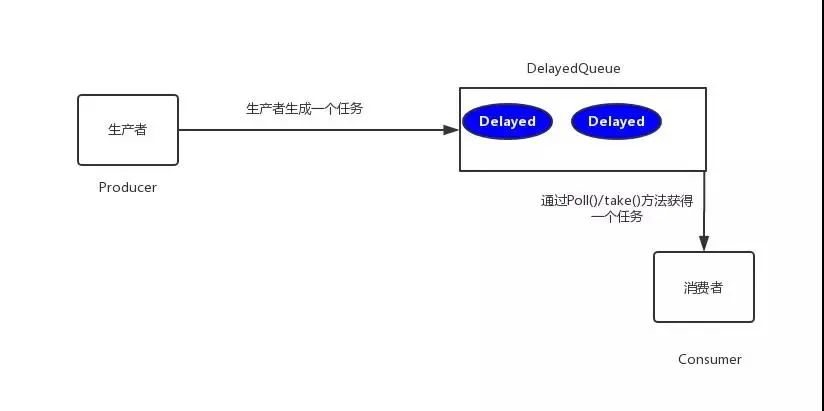
Where Poll(): get and remove the timeout element of the queue. If there is no timeout element, return null
take(): get and remove the timeout element of the queue. If not, wait for the current thread until an element meets the timeout condition and return the result.
realization
Define a class OrderDelay to implement Delayed. The code is as follows
package com.rjzheng.delay2;
import java.util.concurrent.Delayed;
import java.util.concurrent.TimeUnit;
public class OrderDelay implements Delayed {
private String orderId;
private long timeout;
OrderDelay(String orderId, long timeout) {
this.orderId = orderId;
this.timeout = timeout + System.nanoTime();
}
public int compareTo(Delayed other) {
if (other == this)
return 0;
OrderDelay t = (OrderDelay) other;
long d = (getDelay(TimeUnit.NANOSECONDS) - t
.getDelay(TimeUnit.NANOSECONDS));
return (d == 0) ? 0 : ((d < 0) ? -1 : 1);
}
//Returns how much time is left before your custom timeout
public long getDelay(TimeUnit unit) {
return unit.convert(timeout - System.nanoTime(),TimeUnit.NANOSECONDS);
}
void print() {
System.out.println(orderId+"The order number will be deleted....");
}
}
The running test Demo is, and we set the delay time to 3 seconds
package com.rjzheng.delay2;
import java.util.ArrayList;
import java.util.List;
import java.util.concurrent.DelayQueue;
import java.util.concurrent.TimeUnit;
public class DelayQueueDemo {
public static void main(String[] args) {
// TODO Auto-generated method stub
List<String> list = new ArrayList<String>();
list.add("00000001");
list.add("00000002");
list.add("00000003");
list.add("00000004");
list.add("00000005");
DelayQueue<OrderDelay> queue = newDelayQueue<OrderDelay>();
long start = System.currentTimeMillis();
for(int i = 0;i<5;i++){
//Take out with three seconds delay
queue.put(new OrderDelay(list.get(i),
TimeUnit.NANOSECONDS.convert(3,TimeUnit.SECONDS)));
try {
queue.take().print();
System.out.println("After " +
(System.currentTimeMillis()-start) + " MilliSeconds");
} catch (InterruptedException e) {
// TODO Auto-generated catch block
e.printStackTrace();
}
}
}
}
The output is as follows
00000001 The order number will be deleted.... After 3003 MilliSeconds 00000002 The order number will be deleted.... After 6006 MilliSeconds 00000003 The order number will be deleted.... After 9006 MilliSeconds 00000004 The order number will be deleted.... After 12008 MilliSeconds 00000005 The order number will be deleted.... After 15009 MilliSeconds
It can be seen that the delay is 3 seconds and the order is deleted
Advantages and disadvantages
Advantages: high efficiency and low task trigger time delay.
Disadvantages:
(1) After the server restarts, all the data disappears for fear of downtime. (2) cluster expansion is quite troublesome. (3) due to memory constraints, such as too many unpaid orders, it is easy to have OOM exceptions. (4) the code complexity is high
(3) Time wheel algorithm
thinking
Let's start with a picture of the time wheel (this picture is everywhere)
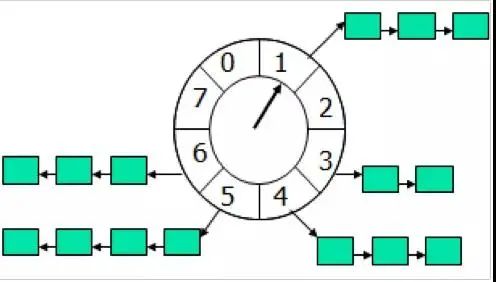
The time wheel algorithm can be similar to the clock. As shown in the figure above, the arrow (pointer) rotates at a fixed frequency in a certain direction. Each jump is called a tick. It can be seen that the timing wheel consists of three important attribute parameters, ticksPerWheel (number of ticks in a round), tickDuration (duration of a tick) and timeUnit (time unit). For example, when ticksPerWheel=60, tickDuration=1, timeUnit = seconds, this is completely similar to the constant second hand walking in reality.
If the current pointer is above 1 and I have a task that needs to be executed in 4 seconds, the thread callback or message of this execution will be placed on 5. What if it needs to be executed after 20 seconds? Because the number of slots in this ring structure is only 8, if it takes 20 seconds, the pointer needs to rotate two more turns. The position is above 5 after 2 turns (20% 8 + 1)
realization
We use Netty's HashedWheelTimer to implement it
Add the following dependencies to Pom
<dependency> <groupId>io.netty</groupId> <artifactId>netty-all</artifactId> <version>4.1.24.Final</version> </dependency>
The test code HashedWheelTimerTest is as follows
package com.rjzheng.delay3;
import io.netty.util.HashedWheelTimer;
import io.netty.util.Timeout;
import io.netty.util.Timer;
import io.netty.util.TimerTask;
import java.util.concurrent.TimeUnit;
public class HashedWheelTimerTest {
static class MyTimerTask implements TimerTask{
boolean flag;
public MyTimerTask(boolean flag){
this.flag = flag;
}
public void run(Timeout timeout) throws Exception {
// TODO Auto-generated method stub
System.out.println("I'm going to the database to delete the order....");
this.flag =false;
}
}
public static void main(String[] argv) {
MyTimerTask timerTask = new MyTimerTask(true);
Timer timer = new HashedWheelTimer();
timer.newTimeout(timerTask, 5, TimeUnit.SECONDS);
int i = 1;
while(timerTask.flag){
try {
Thread.sleep(1000);
} catch (InterruptedException e) {
// TODO Auto-generated catch block
e.printStackTrace();
}
System.out.println(i+"Seconds have passed");
i++;
}
}
}
The output is as follows
1 Seconds have passed 2 Seconds have passed 3 Seconds have passed 4 Seconds have passed 5 Seconds have passed I'm going to the database to delete the order.... 6 Seconds have passed
Advantages and disadvantages
Advantages: high efficiency, task trigger time, lower delay time than delayQueue, and lower code complexity than delayQueue.
Disadvantages:
(1) After the server is restarted, the data disappears completely for fear of downtime
(2) Cluster expansion is quite troublesome
(3) Due to memory constraints, such as too many unpaid orders, it is easy to have OOM exceptions
(4)redis cache
-
Train of thought 1
Using Zset of redis, Zset is an ordered set. Each element (member) is associated with a score, and the value in the set is obtained through score sorting
Add element: ZADD key score member [[score member] [score member]...]
Query elements in order: zrange key start stop [with scores]
Query element score:ZSCORE key member
Remove element: ZREM key member [member...]
The test is as follows
Add a single element redis> ZADD page_rank 10 google.com (integer) 1 Add multiple elements redis> ZADD page_rank 9 baidu.com 8 bing.com (integer) 2 redis> ZRANGE page_rank 0 -1 WITHSCORES 1) "bing.com" 2) "8" 3) "baidu.com" 4) "9" 5) "google.com" 6) "10" Of query elements score value redis> ZSCORE page_rank bing.com "8" Remove a single element redis> ZREM page_rank google.com (integer) 1 redis> ZRANGE page_rank 0 -1 WITHSCORES 1) "bing.com" 2) "8" 3) "baidu.com" 4) "9"
So how to achieve it? Set the time-out stamp of the first order element and the time-out stamp of the first order element respectively, as shown in the figure below
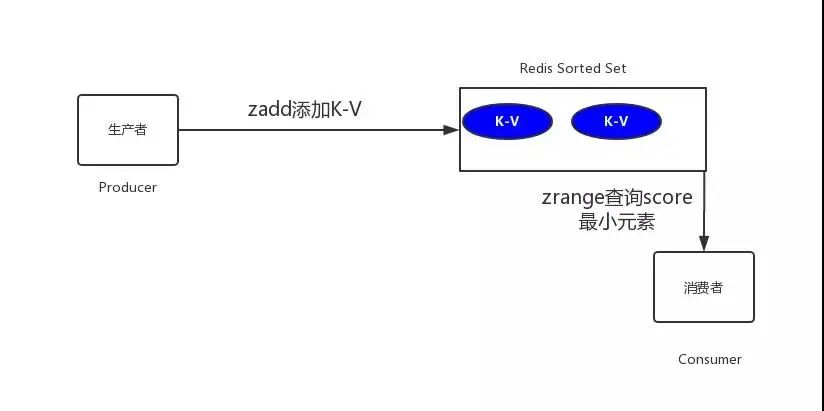
Realize one
package com.rjzheng.delay4;
import java.util.Calendar;
import java.util.Set;
import redis.clients.jedis.Jedis;
import redis.clients.jedis.JedisPool;
import redis.clients.jedis.Tuple;
public class AppTest {
private static final String ADDR = "127.0.0.1";
private static final int PORT = 6379;
private static JedisPool jedisPool = new JedisPool(ADDR, PORT);
public static Jedis getJedis() {
return jedisPool.getResource();
}
//Producer, generate 5 orders and put them in
public void productionDelayMessage(){
for(int i=0;i<5;i++){
//Delay 3 seconds
Calendar cal1 = Calendar.getInstance();
cal1.add(Calendar.SECOND, 3);
int second3later = (int) (cal1.getTimeInMillis() / 1000);
AppTest.getJedis().zadd("OrderId",second3later,"OID0000001"+i);
System.out.println(System.currentTimeMillis()+"ms:redis An order task is generated: ID by"+"OID0000001"+i);
}
}
//Consumer, take order
public void consumerDelayMessage(){
Jedis jedis = AppTest.getJedis();
while(true){
Set<Tuple> items = jedis.zrangeWithScores("OrderId", 0, 1);
if(items == null || items.isEmpty()){
System.out.println("There are currently no tasks waiting");
try {
Thread.sleep(500);
} catch (InterruptedException e) {
// TODO Auto-generated catch block
e.printStackTrace();
}
continue;
}
int score = (int) ((Tuple)items.toArray()[0]).getScore();
Calendar cal = Calendar.getInstance();
int nowSecond = (int) (cal.getTimeInMillis() / 1000);
if(nowSecond >= score){
String orderId = ((Tuple)items.toArray()[0]).getElement();
jedis.zrem("OrderId", orderId);
System.out.println(System.currentTimeMillis() +"ms:redis Consume a task: consume orders OrderId by"+orderId);
}
}
}
public static void main(String[] args) {
AppTest appTest =new AppTest();
appTest.productionDelayMessage();
appTest.consumerDelayMessage();
}
}
At this time, the corresponding output is as follows
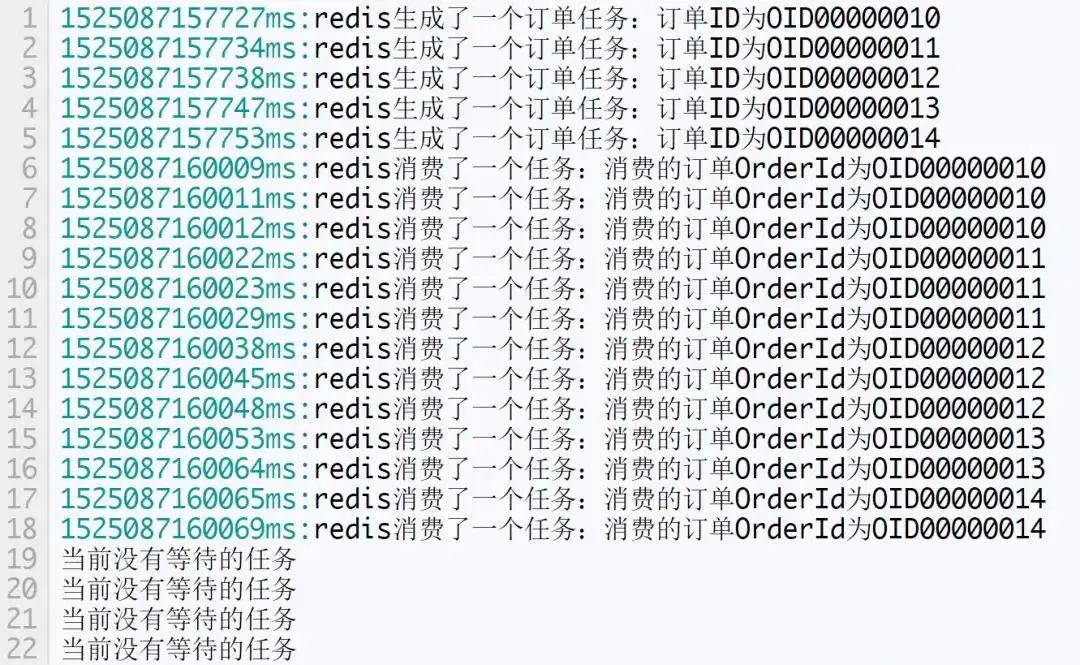
It can be seen that almost three seconds later, consumer orders.
However, there is a fatal flaw in this version. Under the condition of high concurrency, multiple consumers will get the same order number. We tested the code ThreadTest
package com.rjzheng.delay4;
import java.util.concurrent.CountDownLatch;
public class ThreadTest {
private static final int threadNum = 10;
private static CountDownLatch cdl = newCountDownLatch(threadNum);
static class DelayMessage implements Runnable{
public void run() {
try {
cdl.await();
} catch (InterruptedException e) {
// TODO Auto-generated catch block
e.printStackTrace();
}
AppTest appTest =new AppTest();
appTest.consumerDelayMessage();
}
}
public static void main(String[] args) {
AppTest appTest =new AppTest();
appTest.productionDelayMessage();
for(int i=0;i<threadNum;i++){
new Thread(new DelayMessage()).start();
cdl.countDown();
}
}
}
The output is shown below
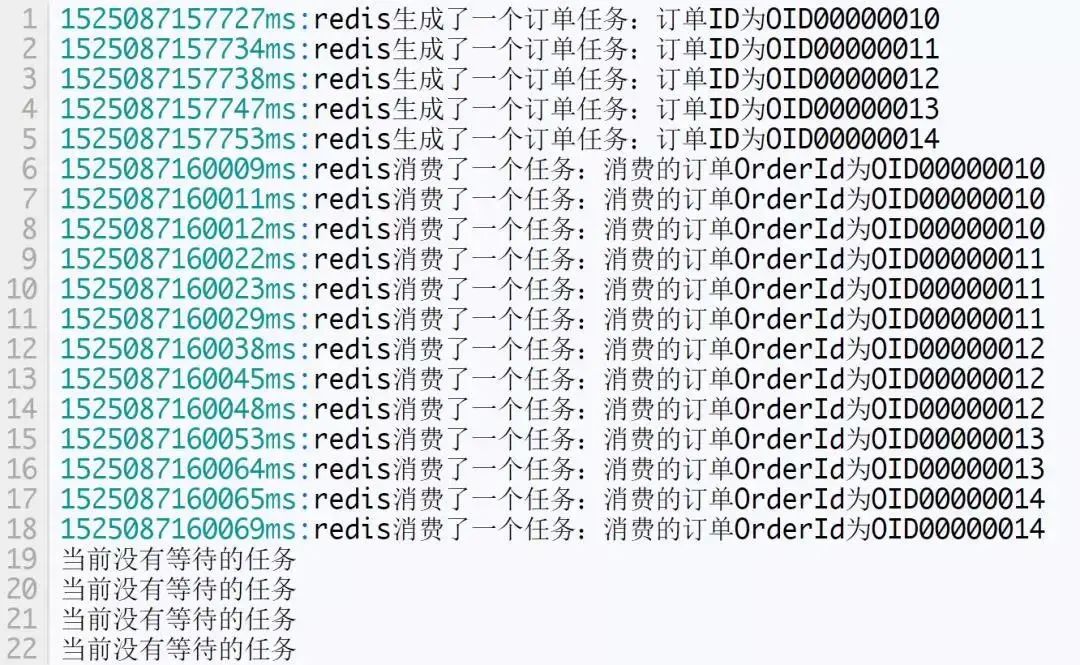
Obviously, multiple threads consume the same resource.
Solution
(1) Using distributed locks, but with distributed locks, the performance decreases. This scheme will not be described in detail.
(2) Judge the return value of ZREM, and consume data only when it is greater than 0, so put the data in the consumerDelayMessage() method
if(nowSecond >= score){
String orderId = ((Tuple)items.toArray()[0]).getElement();
jedis.zrem("OrderId", orderId);
System.out.println(System.currentTimeMillis()+"ms:redis Consume a task: consume orders OrderId by"+orderId);
}
Change to
if(nowSecond >= score){
String orderId = ((Tuple)items.toArray()[0]).getElement();
Long num = jedis.zrem("OrderId", orderId);
if( num != null && num>0){
System.out.println(System.currentTimeMillis()+"ms:redis Consume a task: consume orders OrderId by"+orderId);
}
}
After this modification, rerun the ThreadTest class and find that the output is normal
-
Train of thought II
This scheme uses redis's Keyspace Notifications. The Chinese translation is the key space mechanism, which can provide a callback after the key fails. In fact, redis will send a message to the client. Redis version 2.8 or above is required.
Realize two
On redis Conf, add a configuration
notify-keyspace-events Ex
The operation code is as follows
package com.rjzheng.delay5;
import redis.clients.jedis.Jedis;
import redis.clients.jedis.JedisPool;
import redis.clients.jedis.JedisPubSub;
public class RedisTest {
private static final String ADDR = "127.0.0.1";
private static final int PORT = 6379;
private static JedisPool jedis = new JedisPool(ADDR, PORT);
private static RedisSub sub = new RedisSub();
public static void init() {
new Thread(new Runnable() {
public void run() {
jedis.getResource().subscribe(sub, "__keyevent@0__:expired");
}
}).start();
}
public static void main(String[] args) throws InterruptedException {
init();
for(int i =0;i<10;i++){
String orderId = "OID000000"+i;
jedis.getResource().setex(orderId, 3, orderId);
System.out.println(System.currentTimeMillis()+"ms:"+orderId+"Order generation");
}
}
static class RedisSub extends JedisPubSub {
<ahref='http://www.jobbole.com/members/wx610506454'>@Override</a>
public void onMessage(String channel, String message) {
System.out.println(System.currentTimeMillis()+"ms:"+message+"Order cancellation");
}
}
}
The output is as follows
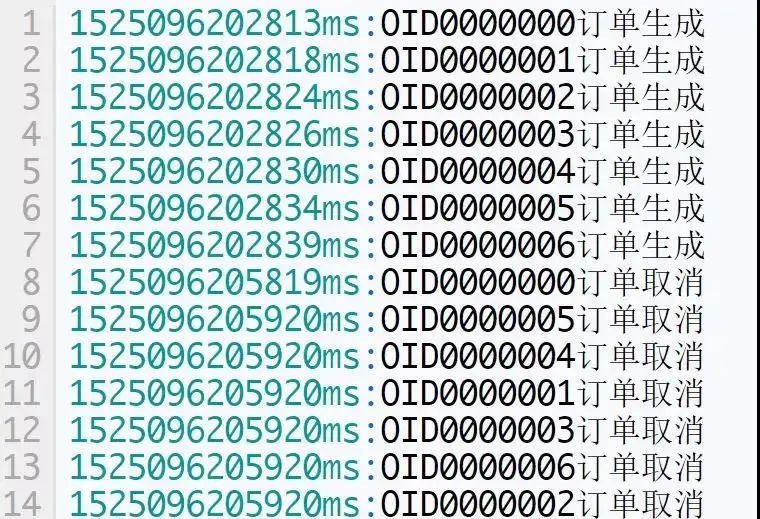
It is obvious that the order was cancelled after 3 seconds
PS: the pub/sub mechanism of redis has a hard injury. The official website is as follows
Original: Because Redis Pub/Sub is fire and forget currently there is no way to use this feature if your application demands reliable notification of events, that is, if your Pub/Sub client disconnects, and reconnects later, all the events delivered during the time the client was disconnected are lost
Redis's publish / subscribe mode is currently fire and forget mode, so reliable notification of events cannot be realized. That is, if the publish / subscribe client is disconnected and reconnected, all events during the client disconnection are lost. Therefore, option 2 is not recommended. Of course, if you don't require high reliability, you can use it.
Advantages and disadvantages
Advantages: (1) since Redis is used as the message channel, all messages are stored in Redis. If the sender or task handler hangs, it is possible to reprocess the data after restarting. (2) Cluster expansion is quite convenient. (3) high time accuracy
Disadvantages: (1) additional redis maintenance is required
(5) Using message queuing
We can use rabbitmq's delay queue. Rabbitmq has the following two features to implement delay queues
RabbitMQ can set x-message-tt for Queue and Message to control the lifetime of the Message. If it times out, the Message will become dead letter
lRabbitMQ Queue can be configured with two parameters: x-dead-letter-exchange and x-dead-letter-routing-key (optional), which are used to control the rerouting of deadletter in the Queue according to these two parameters. Combining the above two features, we can simulate the function of delayed message. Specifically, I'll write another article another day. It's too long to talk about it here.
Advantages and disadvantages
Advantages: high efficiency, easy horizontal expansion by using the distributed characteristics of rabbitmq, message persistence support and increased reliability.
Disadvantages: its ease of use depends on rabbitMq's operation and maintenance Because rabbitMq is referenced, the complexity and cost become higher